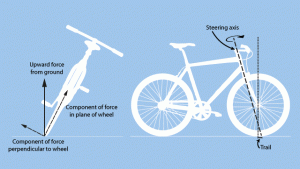Bicycles are such a common sight on the streets of Oxford that most of us barely give them a second thought. But there’s something a little puzzling about the unassuming bicycle. A stationary bike is very unstable and will fall over immediately if unsupported, but a moving bike is somehow much more stable. Where does this stability come from? Surprisingly, even though bicycles are so ubiquitous, the origins of this effect have only recently been established.
As experienced riders will know, if a bicycle begins to fall to one side, the best way to prevent toppling over is to steer the handlebars in the direction of the lean, causing the bicycle to turn in that direction. The rider’s natural tendency however, is to continue travelling in a straight line and so when the bicycle turns one way, he will feel as though he is being pushed in the opposite direction. Thus if the bicycle is turning into the lean, the rider will be pushed upwards, and this helps to keep him and the bike upright. Furthermore, the faster the bicycle is travelling, the faster it will curve into its circular path, so the pushing effect will be greater. This explains why it often seems easier to ride a bike quickly rather than slowly.
The problem, however, is that bicycles are clearly much more stable when moving than when stationary even without a rider; a runaway bicycle can go quite some distance before falling over. We’ve all seen daredevils riding ‘hands off’—their bicycles are still stable but they’re not producing this effect by turning the handlebars, so some other mechanism must be at work.
That mechanism involves the turning effect produced by the force of the ground acting upwards on the front wheel. This turning effect relies on a small detail of bicycle frame construction: you’ll find that the place where the front wheel touches the ground is always just behind the place where the steering axis (the line passing through the bar that connects the handlebars to the front wheel) intersects the ground; this gap is known as the bikes trail.
When a bicycle leans to the right, the upwards force from the ground can be split into two parts—one parallel to the wheel, and another perpendicular to it and pointing to the left. The leftwards force is acting through the point of contact, and since that point is offset from the steering axis, it produces a turning effect about the steering axis, which causes the wheel to rotate to the right. Therefore the bicycle starts to travel in a semicircular path, and this path then produces the stabilising effect explained above.
A similar effect can be observed even when the bike is stationary. When you hold the bicycle by the saddle and then lean it slightly to the right, you will find that the wheel turns to the right of its own accord. However while the bike is stationary this effect doesn’t produce any increase in stability—it is only useful when the bicycle is moving, because it causes the bicycle to travel in a circular path and thus helps keep it upright.
Of course, there’s also some skill involved in staying on your bicycle. That’s because the rider can add to these effects by shifting his weight around to produce changes in the force exerted by the ground on the wheel, thus increasing or decreasing the turning effect. But the phenomenon will still occur without any intervention at all from the rider – which explains why bicycles are still stable without a rider, and also why it’s possible to ride a bike without understanding the physics behind it!
Emily Adlam is a 2nd year undergraduate student at Queen’s College studying Physics and Philosophy.
![Staying Upright Bicycles are such a common sight on the streets of Oxford that most of us barely give them a second thought. But there’s something a […]](/wp-content/uploads/2011/10/Staying-Upright_preview-620x300.gif)
